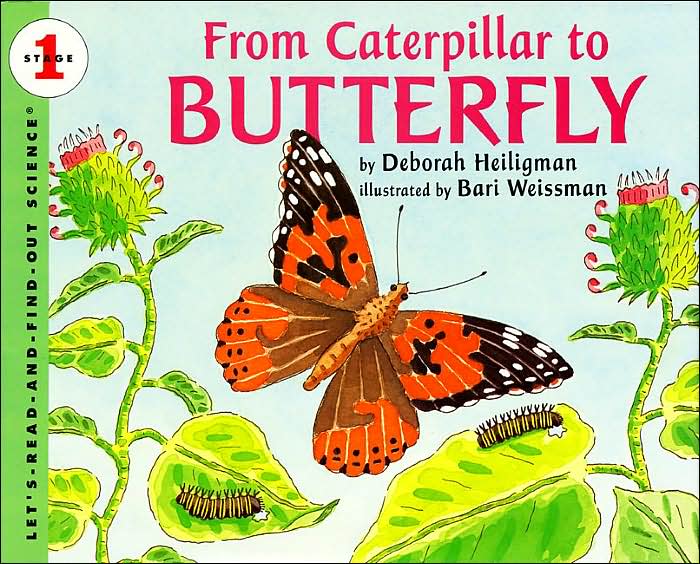The following items would be included in a Discovery/Investigation box for children to learn about the life cycle of insects. This could be utilized in a home or classroom setting to foster an understanding of scientific observation.
Here are some excellent texts to include in a butterfly investigation!
| Caterpillars, Bugs, and Butterflies by Mel Boring |
| Monarch Butterfly by Gail Gibbons |
The Very Hungry Caterpillar by Eric Carle
 | |
| From Caterpillar to Butterfly by Deborah Heiligman |
- Caterpillars, Bugs, and Butterflies is an informational, nonfiction text that presents fun facts about these fascinating creatures in a child-friendly format. Did-you-know facts are accompanied by detailed pictures that will keep students engaged.
- Monarch Butterfly is another nonfiction text that provides factual information on the life cycle of the butterfly. It also identifies important information, such as natural habitat, food, and the identification of body parts.
- The Very Hungry Caterpillar is a classic tale of a certain small caterpillar who began to become very very hungry up until the point where he formed a chrysalis. He then sprouts his wings and becomes a beautiful butterfly! You can find a supplemental teaching lesson plan for Eric Carle's The Very Hungry Caterpillar by visiting Scholastic's website: http://www.scholastic.com/teachers/lesson-plan/very-hungry-caterpillar-teaching-plan.
- From Caterpillar to Butterfly is a basic text detailing the different stages of growth and development for the butterfly.
Life
Cycle Video
To
continue in your insect investigation, click below to view a really neat
National Geographic video that shows the process of growth from the time an egg
is hatched to the butterfly's migration.
This
is from the series "Growing Up Butterfly". Enjoy!
Butterfly
Life Cycle Craft
Next in our discovery box is the completion of a craft activity (a.k.a. "craftivity")--my
favorite!! Here's a way for student to demonstrate their knowledge of the life
cycle of butterflies using beans and dried noodles. Here's what the
finished product would look like:
Cute
right?! Other life cycle extension activities can be found at the original
website: http://kindergartenlessonplans.org/1661/easter-craftivity-the-life-cycle-of-a-butterfly/
Butterfly
and Moth Poster
In
my investigation box or science corner, I would be sure to include a poster,
such as this one, to aid in student's understanding of moths and butterflies.
This would allow students to see that there are many different species of moths
and butterflies that are found in many different areas all over the world! Each
poster contains the common name of the butterfly or moth, its biological name,
and where it can be found.
#1
Butterflies of the World
#2
Moths of the World
Additional
Fun Crafts
Here
are two other fun crafts that could supplement a butterfly unit:
#1
Coffee Filter Butterfly
Materials:
- Paper coffee filters
- Washable markers
- Spray bottle of water
- Black or brown pipe cleaners
- Paper plate/newspaper/disposable table cloth
Instructions:
- Lay down newspaper, a disposable plastic table cloth or give each child a plate to color on. (This will protect the table surface from the marker as it will run when wet!)
- Allow children to color a design on the coffee filter. *You may want to flatten the coffee filters prior to coloring*
- At the completion of their coloring, spritz the coffee filter lightly with the spray bottle until the colors begin to mix and run together to form a tie dye effect.
- While coffee filter is drying, fold pipe cleaner in half.
- When colors are dry, fold the filter back and forth in a fan or accordion-style fold.
- Pinch the middle of the filter and insert folded pipe cleaner.
- Twist the ends of the pipe cleaner together to secure it.
- Fold ends down about 1/4 inch to create the antennae.
- Fan out the butterfly wings.
- Hang up your butterflies to enjoy!
To see full instructions, go
to http://crafts.kaboose.com/butterfly1.html
#2
Egg Carton Caterpillars
Materials:
- 1 cardboard egg carton
- Scissors
- Poster paint
- Paintbrush
- Black or brown pipe cleaners
- Googly eyes
- Craft glue
- Markers
- Construction paper (Optional for legs)
Instructions:
- Cut egg carton into 6-hump halves.
- Paint caterpillar with desired colors. (Again, you may want to cover your surface with newspaper or a disposable table cloth).
- Wait for paint to dry before gluing googly eyes to the front end of the caterpillar.
- Decorate face/body with markers. (Note: you may also want to decorate your caterpillar masterpiece with any other craft supplies on hand--i.e. glitter, pom-poms, buttons...whatever strikes your fancy:)
- Poke a hole in the top of the head to make room for the pipe cleaner.
- Fold pipe cleaner in half and twirl edges around your finger or a pencil for the antennae. Poke through the hole.
To see full instructions, go to http://www.elmers.com/teachers/project/egg-carton-caterpillar
In-Class
Science Investigation
What
better way to engage children in learning about caterpillars and butterflies
than actually observing them in the classroom?! This was definitely a popular
activity for elementary teachers whenever I was younger. Beginning from a tiny
larvae to a caterpillar to forming a chrysalides/cacoons to the transformation
into a beautiful butterfly, your children can take part in this wonderful life
process! Students can take part in the feeding and care of these insects, in
addition to taking on the role of a real life scientist by documenting the
caterpillar's growth. The following website gives specific information on how
to obtain caterpillars in the classroom/home setting and the proper care of
these insects:
Extra
information on raising butterflies:
These
are just a few ideas to jump start an investigation of caterpillars and
butterflies. There are so many ways to incorporate science into the classroom
and into everyday life at home! Happy exploring!






No comments:
Post a Comment